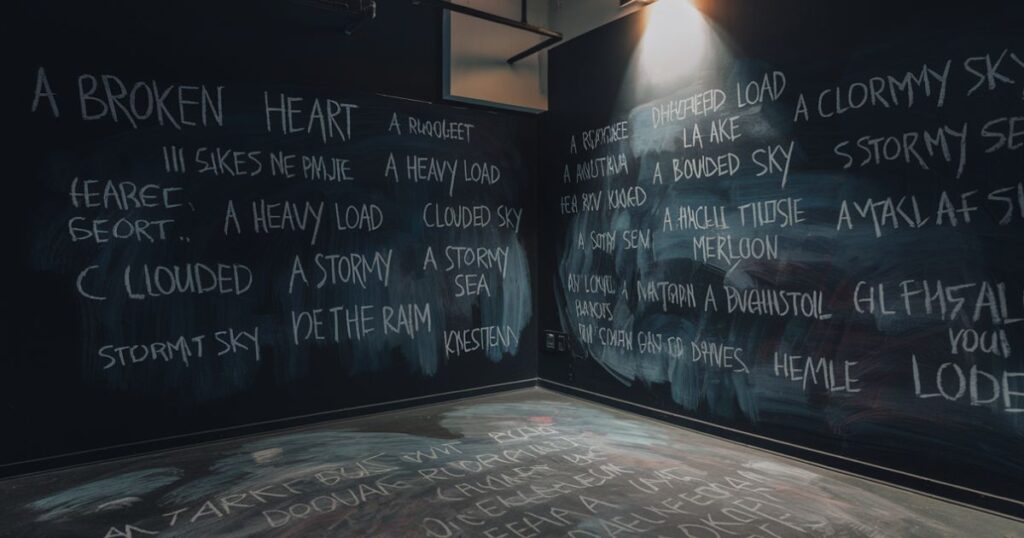Sadness is a complex emotion that everyone experiences at some point. Sometimes, finding the right words to describe how we feel can be difficult. That’s where 31 metaphors for sadness can help paint a clearer picture of sadness. In this article, we’ll explore 31 metaphors for sadness, showing how language can capture different shades of sorrow.
From “a heavy cloud” to “a sinking ship,” these metaphors express feelings that may be difficult to describe. Each metaphor provides a unique way to understand and communicate the emotion. As we go through them, you’ll see how these comparisons can deepen your understanding of sadness and make it easier to express your feelings to others.
1. A Heavy Cloud
Imagine sadness as a heavy cloud hanging over your head. It darkens your day, blocking out the sun’s warmth and light. This metaphor captures the oppressive nature of sadness and how it can overshadow everything else in life.
Example: In an email to a friend, Sarah writes, “Hey Alex, I’ve been feeling under a heavy cloud lately. Work’s been tough, and I can’t seem to shake this gloom. Fancy grabbing a coffee this weekend?”
2. A Sinking Ship
Sadness can feel like being on a sinking ship, slowly but surely being pulled under by the weight of your emotions. This metaphor highlights the sense of helplessness and impending doom that often accompanies profound sadness.
Example: A journal entry might read: “Today, I feel like I’m on a sinking ship. Each moment, I’m closer to being submerged in this sea of sorrow. Will I ever find my way back to shore?”
3. A Wilting Flower
Like a flower deprived of water and sunlight, sadness can make you feel as though you’re wilting away. This metaphor speaks to the drain on vitality that sadness often brings.
Example: In a text to a therapist: “Dr. Martinez, I need to reschedule our session. I’m feeling like a wilting flower today and don’t have the energy to leave the house.”
4. A Rainy Day

Sadness can be likened to a rainy day – gloomy, gray, and seemingly endless. This metaphor captures the all-encompassing nature of sorrow and how it can dampen your outlook.
Example: A weather app notification might read: “Emotional forecast: Expect heavy rains of sadness with a chance of tearful showers. Don’t forget your emotional umbrella!”
Read also this blog: 35 Metaphors for Summer: The Vivid Canvas of the Warm Season
5. A Broken Mirror
Sadness can feel like looking into a broken mirror, where your reflection – and your world – appears fragmented and distorted. This metaphor illustrates how sadness can shatter our perception of ourselves and our surroundings.
Example: In a poem: “I gaze into the broken mirror of my soul, each shard reflecting a piece of my shattered joy.”
6. A Heavy Blanket
Imagine sadness as a heavy blanket draped over you. It’s comforting in a way, but also suffocating and immobilizing. This metaphor captures how sadness can both protect and hinder us.
Example: In a voice note to a friend: “Hey Lisa, I’m wrapped up in that heavy blanket of sadness again. It’s warm, but I can hardly move. Mind coming over with some tea?”
7. A Dark Tunnel

Sadness can feel like being lost in a dark tunnel with no end in sight. This metaphor emphasizes the sense of disorientation and hopelessness that often accompanies profound sadness.
Example: A motivational poster might read: “Feeling lost in the dark tunnel of sadness? Remember, every tunnel has an end. Keep moving forward.”
8. A Leaden Heart
The weight of sadness can make your heart feel like it’s made of lead. This metaphor captures the physical heaviness that often comes with emotional pain.
Example: In a song lyric: “With a heart of lead, I trudge through days, wondering when this weight will lift from my chest.”
9. A Faded Photograph
Sadness can make life seem like a faded photograph – the colors are muted, the edges blurred. This metaphor illustrates how sadness can dull our perception of the world around us.
Example: In a social media post: “Life feels like an old, faded photograph lately. Anyone else experiencing this Instagram vs. Reality moment?”
10. A Barren Landscape
Imagine sadness as a barren, desolate landscape. This metaphor captures the sense of emptiness and isolation that often accompanies deep sadness.
Example: In a travel journal: “My emotional journey has led me to this barren landscape of sadness. No landmarks in sight, just endless, empty horizons.”
11. A Stormy Sea

Sadness can feel like being tossed about on a stormy sea, with waves of emotion threatening to overwhelm you. This metaphor highlights the turbulent nature of sadness and its ability to make us feel out of control.
Example: In a group chat message: “Guys, I’m navigating some stormy emotional seas right now. Could use a virtual life raft if anyone’s free to talk.”
12. A Crumbling Castle
Sadness can make you feel like your emotional fortress is crumbling around you. This metaphor speaks to the way sadness can erode our sense of security and stability.
Example: In a therapy session: “Dr. Johnson, it’s like I’m watching my emotional castle crumble. Walls I’ve built for years are just… falling apart.”
13. A Bottomless Pit
The depth of sadness can sometimes feel like a bottomless pit you’re falling into. This metaphor captures the sense of endlessness and despair that profound sadness can bring.
Example: In a diary entry: “Dear Diary, today feels like I’m falling into a bottomless pit of sadness. Will I ever hit the ground and start climbing out?”
14. A Gray Filter
Imagine sadness as a gray filter placed over your eyes, dulling the colors of the world. This metaphor illustrates how sadness can alter our perception and rob life of its vibrancy.
Example: In an art class: “Today, we’ll explore how emotions affect our art. Imagine painting your world through a gray filter of sadness. What colors would you use?”
15. A Heavy Backpack
Sadness can feel like carrying a heavy backpack that you can’t take off. This metaphor emphasizes the persistent burden of sadness and how it can weigh us down in our daily lives.
Example: In a fitness app update: “Emotional workout: Carried the heavy backpack of sadness for another day. Looking forward to lightening the load soon.”
16. A Withering Tree
Like a tree losing its leaves in autumn, sadness can make us feel like we’re slowly withering away. This metaphor captures the sense of gradual decline that often accompanies prolonged sadness.
Example: In a gardening blog post: “Sometimes, our emotions are like seasons. Right now, I’m a withering tree in the autumn of sadness, but spring will come again.”
17. A Foggy Day

Sadness can be like a foggy day, obscuring our vision and making it hard to navigate. This metaphor highlights how sadness can cloud our judgment and make decision-making difficult.
Example: In a weather-themed mood tracker: “Today’s emotional forecast: Dense fog of sadness. Visibility low. Proceed with caution and self-care.”
18. A Broken Record
Sometimes, sadness feels like a broken record, playing the same melancholic tune over and over. This metaphor captures the repetitive nature of sad thoughts and feelings.
Example: In a music therapy session: “It’s like I’m stuck listening to this broken record of sadness. Can we find a way to change the track?”
19. A Dull Ache
Sadness can manifest as a persistent, dull ache in our hearts. This metaphor emphasizes the physical sensation that often accompanies emotional pain.
Example: In a doctor’s appointment: “Doc, I know you can’t see it on any scans, but there’s this dull ache of sadness that just won’t go away.”
20. A Fading Light

Imagine sadness as a light slowly fading away, leaving you in increasing darkness. This metaphor illustrates the gradual loss of hope and joy that can come with prolonged sadness.
Example: In a meditation app prompt: “Visualize your inner light. If sadness has dimmed it, imagine slowly turning up the brightness again.”
21. A Maze Without an Exit
Sadness can feel like being trapped in a maze with no way out. This metaphor captures the sense of confusion and helplessness that often accompanies deep sadness.
Example: In a puzzle game review: “This game perfectly captures the feeling of navigating the maze of sadness. Challenging, disorienting, but ultimately solvable.”
Read also this blog: 35 Metaphors For Love
22. A Cold Winter
Like a long, cold winter, sadness can make everything feel frozen and lifeless. This metaphor highlights the numbing effect sadness can have on our emotions and experiences.
Example: In a seasonal affective disorder support group: “It’s like I’m stuck in an emotional winter. Everything feels cold and barren. Anyone else feeling this endless chill?”
23. A Tattered Map
Sadness can make life feel like navigating with a tattered, incomplete map. This metaphor emphasizes how sadness can leave us feeling lost and directionless.
Example: In a life coaching session: “Coach, I feel like I’m trying to navigate life with this tattered emotional map. Can you help me find my bearings again?”
24. A Dimming Star
Imagine your inner light as a star, slowly dimming under the weight of sadness. This metaphor captures the sense of fading vitality that often accompanies profound sadness.
Example: In an astronomy-themed self-help book: “Your inner star may be dimmed by sadness, but remember – even the faintest stars still shine in the darkness.”
25. A Slow-Motion World

Sadness can make the world feel like it’s moving in slow motion while you’re stuck in place. This metaphor highlights the disconnect we often feel from the world around us when we’re sad.
Example: In a film director’s notebook: “Scene idea: Protagonist moves in slow motion through a normal-speed world, visualizing the isolating effect of sadness.”
26. A Muted Symphony
Like a beautiful symphony played at low volume, sadness can make life’s joys feel distant and muffled. This metaphor illustrates how sadness can dampen our ability to fully experience positive emotions.
Example: In a music review: “This piece perfectly captures the muted symphony of sadness – all the notes are there, but they’re subdued, distant, longing to be heard fully.”
27. A Heavy Door
Sadness can feel like trying to push open a heavy door that won’t budge. This metaphor captures the sense of struggle and the effort required to overcome sadness.
Example: In a home renovation show: “Today, we’re not just fixing doors – we’re learning how to push through the heavy doors of sadness in our lives.”
28. A Fading Echo
Imagine happiness as a sound, and sadness as its fading echo. This metaphor emphasizes how sadness can feel like a lingering reminder of joy that’s slipping away.
Example: In a sound engineering class: “Let’s experiment with creating a fading echo effect. It’s like capturing the sound of sadness as it echoes past happiness.”
29. A Tangled Ball of Yarn

Sadness can make our thoughts and emotions feel like a tangled ball of yarn. This metaphor highlights the confusion and complexity of our feelings when we’re sad.
Example: In a knitting circle: “Sometimes, our emotions are like this tangled yarn. We can Slowly and patiently unravel the sadness and create something beautiful.”
30. A Sepia-Toned World
Like an old sepia photograph, sadness can drain the color of our world. This metaphor captures how sadness can alter our perception, making everything seem less vibrant.
Example: In a photography workshop: “Today’s challenge: Capture the essence of sadness using only sepia tones. How does this limited palette affect the mood of your images?”
31. A Distant Shore
Happiness can feel like a distant shore when we’re swimming in an ocean of sadness. This metaphor emphasizes the sense of separation and longing that often accompanies sadness.
Example: In a travel blog post: “Sometimes, happiness feels like a distant shore. But remember, every stroke through this ocean of sadness brings you closer to land.”
Conclusion
These 31 metaphors for sadness offer a glimpse into the complex emotional landscape of sadness. They remind us that sadness is a universal experience but also deeply personal and unique to each individual. By exploring these metaphors, we can better understand and express our emotions, fostering empathy and connection with others navigating similar emotional land.
Remember, just as these metaphors illustrate the depth and complexity of sadness, they also hint at the possibility of change. Clouds disperse, ships can be righted, winters end, and distant shores can be reached. In understanding and acknowledging our sadness, we take the first step towards moving through it.

James Smith is an experienced blogger at PhrasePick, where he shares his expertise in English grammar and figurative language. With a passion for simplifying complex topics, James creates engaging content that helps readers master the nuances of the English language.





